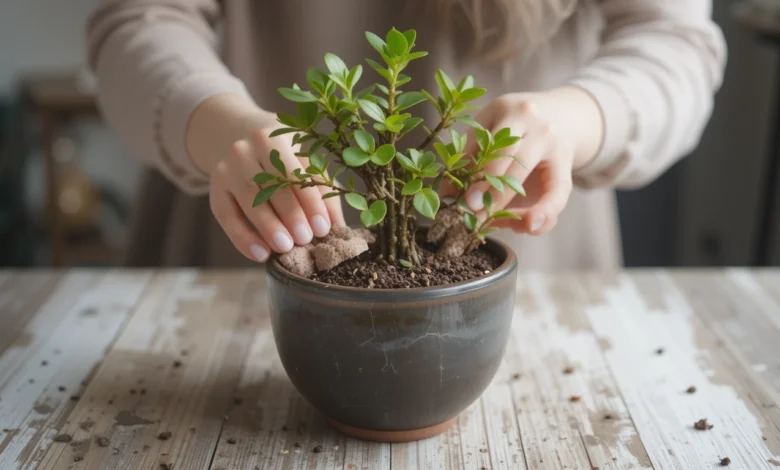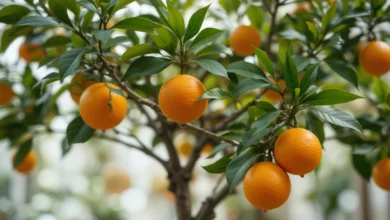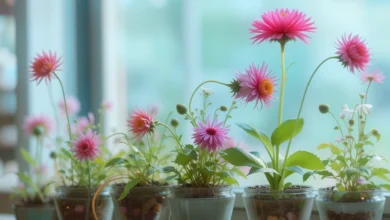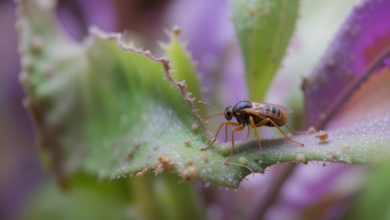How to Repot a Jade Plant – Step-by-Step Guide for Healthy Growth

Jade plants are some of the most popular houseplants around. Known for their thick, shiny leaves and easy care, jade plants are a great choice for beginner gardeners. However, like any plant, they need proper care and occasional repotting to stay healthy and thrive.
If you’ve noticed that your jade plant has outgrown its pot, or if its roots are beginning to poke through the drainage holes, it may be time to repot it. In this guide, we’ll walk you through everything you need to know about repotting your jade plant, from choosing the right pot to how to take care of it after the move.
Let’s get started!
Why Should You Repot a Jade Plant?
Before we dive into the step-by-step process, it’s essential to understand why you should repot your jade plant. Here are the main reasons:
1. Growth Needs
As your jade plant grows, its roots need more space to spread out. If the roots become cramped, they might not be able to absorb enough nutrients and water. This can slow down the growth of the plant, and eventually, the jade plant may become unhealthy.
2. Root Health
If you notice roots growing out of the drainage holes of the pot, it’s a sign that your jade plant is becoming root-bound. When the plant’s roots fill the pot, they might start growing in circles, which could cause the roots to become weak or damaged. Repotting gives the roots more space and ensures they grow strong and healthy.
3. Fresh Soil
Over time, the soil in your jade plant’s pot can lose its nutrients and become compacted. Fresh soil will provide your plant with new nutrients, which can help it grow better and look healthier.
When to Repot a Jade Plant?
Timing is essential when repotting your jade plant. Repotting should be done during the plant’s active growing season, which is usually spring or early summer. This is when the jade plant is most likely to bounce back quickly and adapt to its new pot.
- Signs your jade plant needs repotting:
- The roots are poking out of the drainage holes.
- The plant seems top-heavy or wobbly in its pot.
- The plant has stopped growing or its leaves are looking pale.
- The soil has become hard and compact.
If your jade plant doesn’t show any of these signs, you may not need to repot it just yet. Repotting too often can stress the plant, so it’s best to wait until it genuinely needs more space.
How to Repot a Jade Plant: A Step-by-Step Guide
Now that you know why and when to repot your jade plant, let’s go through the process step by step.
Materials You Will Need
Before you begin, make sure you have everything ready:
- A new pot (1-2 inches larger in diameter than the current one)
- Fresh, well-draining potting mix (cactus or succulent mix is ideal)
- A trowel or small shovel
- Gardening gloves (optional)
- A small piece of mesh (to cover the drainage hole)
- A saucer for catching excess water
Step 1: Choose the Right Pot
The first thing you’ll need is a new pot. Choose a pot that’s about 1-2 inches larger in diameter than the current pot. A pot that’s too large can lead to overwatering and root rot, so don’t go much bigger than that.
Make sure the pot has drainage holes at the bottom. Jade plants, like most succulents, don’t like to sit in water, so good drainage is crucial.
Step 2: Prepare the New Pot
Before you start removing the plant, place a small piece of mesh or a coffee filter over the drainage holes in the new pot. This will prevent the soil from washing out when you water the plant.
Next, fill the bottom of the new pot with a small layer of fresh potting mix. This layer should be about 1-2 inches deep.
Step 3: Remove the Jade Plant from Its Current Pot
Gently tilt the jade plant to one side and carefully remove it from its current pot. If the plant is stuck, gently tap the sides of the pot to loosen the soil.
- Tip: If the plant is particularly stuck, you can carefully slide a small tool (like a butter knife or flathead screwdriver) around the edges to help loosen the soil.
Once the plant is out of the pot, inspect the roots. If the roots are circling around the base of the pot (root-bound), gently untangle them with your fingers or a small tool. Don’t be too rough, as the roots can break easily.
- Tip: Trim any dead or rotting roots with a clean, sharp pair of scissors or pruning shears.
Step 4: Place the Plant in the New Pot
Now that the plant is free, place it in the new pot. Make sure the root ball is sitting at the right height, with the top of the roots about an inch below the rim of the pot. This will allow room for watering without spilling.
Fill in around the roots with fresh potting mix. Gently press the soil down to remove any air pockets, but don’t pack it too tightly. The soil should be firm enough to hold the plant in place, but loose enough to allow water to drain.
- Tip: Leave a small gap at the top of the pot (about half an inch) so that water doesn’t overflow when you water the plant.
Step 5: Water the Plant
Once the jade plant is in its new pot, water it thoroughly. This helps settle the soil around the roots and ensures the plant has enough moisture to get started in its new home. Be sure to water the plant lightly for the first few days after repotting, as too much water can shock the plant.
Step 6: Let the Plant Settle In
After repotting, place your jade plant in a bright, sunny location. Keep it out of direct sunlight for the first few days, as it may be stressed from the move. Allow the plant to adjust to its new environment before resuming your regular care routine.
It’s also a good idea to avoid watering the jade plant for the next 1-2 weeks, as this gives the roots time to recover and settle into the new soil.
- Tip: For the first few days, keep an eye on your jade plant to ensure it doesn’t show signs of stress, such as wilting or yellowing leaves.
Caring for Your Jade Plant After Repotting
Repotting can be stressful for plants, so it’s important to give your jade plant some extra care after the move. Here’s what you should do:
1. Watering
For the first week or two, water the jade plant lightly. Overwatering can cause root rot, so let the soil dry out completely before watering again. Once the plant has settled in, return to your usual watering schedule, which should be once every 2-3 weeks.
2. Light
Jade plants need bright, indirect sunlight. After repotting, make sure your plant gets plenty of light to encourage healthy growth. However, don’t place it in direct sunlight immediately after repotting, as the plant is still adjusting.
3. Fertilizing
You can fertilize your jade plant a few weeks after repotting, but don’t overdo it. Use a diluted, balanced fertilizer for succulents or cacti, and apply it once every 4-6 weeks during the growing season (spring and summer). Avoid fertilizing during the winter months when the plant is dormant.
4. Monitor for Pests
Check your jade plant for pests regularly. Common pests include aphids, mealybugs, and spider mites. If you spot any pests, remove them immediately using a gentle solution like neem oil or insecticidal soap.
Common Mistakes to Avoid When Repotting a Jade Plant
While repotting is generally easy, there are some common mistakes to avoid:
- Choosing a Pot that’s Too Big: A pot that’s too large can lead to overwatering and root rot. Stick to a pot that’s just 1-2 inches larger than the current one.
- Overwatering: After repotting, it’s easy to be tempted to water your plant right away. Be careful not to overwater, as this can cause stress or root rot.
- Using the Wrong Soil: Jade plants need well-draining soil. Avoid using regular potting soil, as it can retain too much moisture. Instead, use cactus or succulent mix.
Conclusion
Repotting a jade plant is an easy and rewarding task that will help your plant grow healthy and strong. By following these simple steps—choosing the right pot, using fresh soil, and giving your plant plenty of care after the move—you’ll set your jade plant up for long-term success. Remember, jade plants are low-maintenance, but they do need the right environment to thrive. With a little attention, your jade plant will grow into a beautiful, thriving addition to your home.




